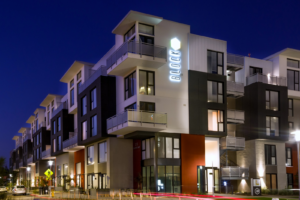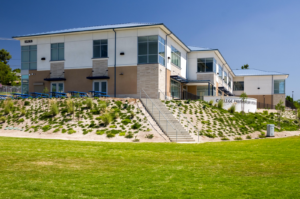Choosing suitable materials for the exterior of a commercial building is crucial for both its durability and aesthetic appeal. Commercial stucco has long been favored for its versatility, resilience, and ease of exterior application. This guide delves into the benefits of stucco, the process of applying it, and design tips to maximize its potential.
The Advantages of Commercial Stucco
Commercial stucco stands out for several reasons. Its adaptability in terms of texture and color makes it an excellent choice for various architectural styles. Stucco’s durability and resistance to weather conditions ensure that buildings look good and are protected against the elements. Furthermore, its energy efficiency contributes to lower heating and cooling costs, making it an economically sound choice for commercial properties.
Choosing the Right Stucco for Your Project
When it comes to exterior application, selecting the right type of stucco is paramount. Traditional stucco, made from Portland cement, sand, and lime, offers a hard, durable finish. On the other hand, synthetic stucco provides a more flexible coating, which can benefit areas prone to seismic activity or extreme temperature changes. Understanding the specific needs of your project will guide you in choosing the most suitable type of stucco.
Application Techniques for Commercial Stucco
The exterior application of stucco involves several critical steps to ensure its longevity and effectiveness. The process includes preparing the surface, applying a base coat, reinforcement with mesh, and the final finish coat. Employing the right techniques and materials during each phase can significantly impact the quality and durability of the stucco exterior.

Design Tips for Enhancing Commercial Exteriors with Stucco
Here are some design tips discussed in detail for enhancing commercial exteriors with stucco:
- Consider the Building’s Architecture: Align the stucco finish with the architectural style of the building. A smooth or subtly textured stucco can complement the clean lines and modern look for industrial styles.
- Color Selection: Choose stucco colors that enhance the building’s features and blend well with the surroundings. Lighter colors can make the structure appear larger, while darker tones provide striking contrast.
- Texture Variations: Utilize different stucco textures to add depth and interest to the exterior. Options include smooth, dash, and lace finishes, among others.
- Incorporate Decorative Elements: Add visual interest with decorative bands, cornices, or stucco moldings that can break up large stucco surfaces and add character.
- Lighting: Use exterior lighting to highlight the texture and color of the stucco, creating a dramatic effect during the evening hours.
- Landscaping: Complement the stucco exterior with thoughtful landscaping. Choose plants and flowers that enhance the building’s aesthetic and consider the maintenance required for the chosen flora.
- Complementary Materials: Mix stucco with other materials such as stone, brick, or wood to create a unique and dynamic facade.
- Energy Efficiency: Opt for stucco colors and finishes that reflect sunlight to improve energy efficiency and reduce cooling costs.
- Curb Appeal: Enhance the building’s curb appeal with a stucco finish that makes a strong first impression and reflects the business’s professionalism.
- Creative Accents: Use stucco to create interesting patterns or accents on the building’s exterior, such as geometric shapes or bands of contrasting colors.
- Durability Enhancements: Consider using fortification layers like Sto Crack Defense to minimize surface cracking and extend the life of the stucco facade.
These design tips help create a visually appealing and durable stucco exterior for commercial buildings, ensuring they stand out and remain in good condition over time.
Maintenance and Care for Stucco Exteriors
Maintaining a stucco exterior is essential for preserving its appearance and structural integrity. Regular inspections can identify potential issues before they become significant problems, and proper cleaning techniques can prevent the buildup of dirt and grime. Understanding the specific care requirements for your type of stucco will help you keep your commercial building looking its best for years to come.
Conclusion
Commercial stucco offers durability, versatility, and aesthetic appeal, making it an excellent choice for commercial building exteriors. By carefully considering the type of stucco exterior application techniques and incorporating design tips, you can enhance your property’s visual appeal and longevity. Regular maintenance ensures that your stucco exterior remains in top condition, protecting your investment and keeping your building attractive to tenants and visitors alike. Stucco is a smart choice for any commercial exterior project with numerous benefits.
Frequently Asked Questions
- What is stucco made of?
Stucco is typically made from Portland cement, sand, lime, and water. Some stucco finishes may include acrylics or glass fibers for added strength and flexibility.
- Can the color of the stucco be changed after application?
Yes, the color of the stucco can be changed. It can be painted over or have a new finish coat applied with the desired color.
- Is stucco a good choice for commercial exteriors in terms of maintenance?
Stucco is known for being low maintenance. It requires occasional cleaning and may need repainting or patching to repair cracks or damage.
- Can stucco be applied over painted surfaces?
Removing existing paint before applying stucco is recommended, as stucco may not adhere well to painted surfaces.
- Are there different textures available for stucco finishes?
Yes, stucco comes in various textures, such as smooth, dash, lace, and others, which can be chosen based on the desired aesthetic.
- What are the advantages of using stucco for commercial buildings?
Stucco offers advantages such as durability, fire resistance, energy efficiency, and aesthetic versatility.
- Can stucco be applied in any climate?
Stucco application requires temperatures to be above 40 degrees Fahrenheit. In colder climates, measures such as tenting and heating may be necessary.
- What should be done if cracks appear in stucco?
Some cracking is normal, but significant or widespread cracking may require repair. Options include patching the cracks or applying a new finish coat.
- How does stucco contribute to the energy efficiency of a building?
Stucco has insulating properties that can help regulate the interior temperature of a building, contributing to energy savings.
- Is stucco fire-resistant?
Yes, due to its cement-based composition, stucco is inherently fire-resistant.
- Can the texture of the stucco be changed?
Yes, the texture of stucco can be changed by applying sufficient coats of stucco and texturing over an existing finish.
Another company we love has an irrigation product for drip irrigation that is game changing: www.irriglide.com



